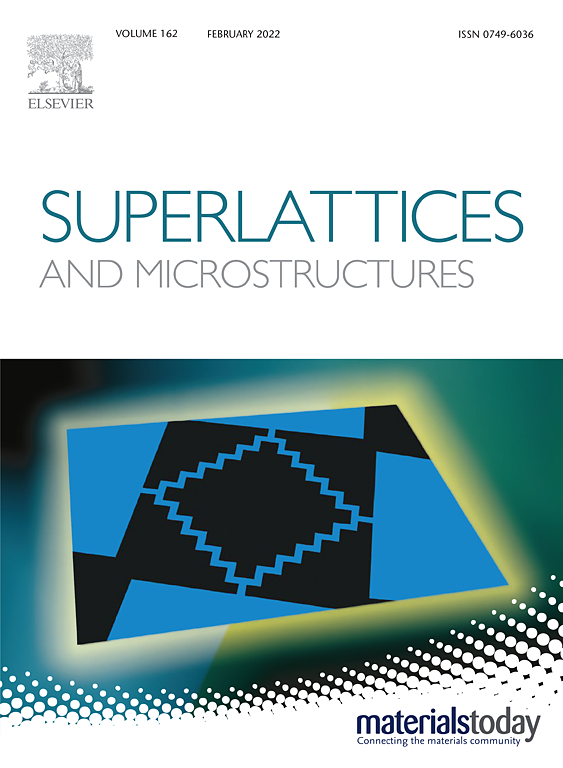la掺杂Pb(Zr,Sn,Ti)O3钙钛矿中一个有趣的倾斜偶极子结构及其在电场下的演变
IF 3.3
3区 物理与天体物理
Q2 PHYSICS, CONDENSED MATTER
引用次数: 4
摘要
尽管电偶极子的排列顺序在介电材料独特的物理性质中起着关键作用,但电偶极子的排列大多表现为简单的平行或反平行。在这里,我们报道了基于先进中子、同步x射线和三维电子衍射技术的la掺杂Pb(Zr,Sn,Ti)O3钙钛矿的倾斜电偶极子结构。结果表明,由于原子位移和氧八面体倾斜之间的耦合,这种独特的电偶极子结构在(110)p平面上呈现倾斜排列,具有沿[110]p方向的反平行分量和沿[001]p方向的平行分量。值得注意的是,在原位电场作用下,电偶极子连续旋转,倾斜角逐渐减小,相场模拟证实了这一点,并最终演变为铁电有序。这样的演化产生了一个小的迟滞和一个等效的晶格应变。这些发现丰富了目前对介电材料中电偶极子构型类型的理解,并有望帮助设计具有涌现特性的新型介电材料。本文章由计算机程序翻译,如有差异,请以英文原文为准。
An intriguing canting dipole configuration and its evolution under an electric field in La-doped Pb(Zr,Sn,Ti)O3 perovskites
Despite the fact that electric dipole ordering plays a key role in the unique physical properties of dielectric materials, electric dipole configurations mostly appear simply as either parallel or antiparallel. Here, we report a canting electric dipole configuration in La-doped Pb(Zr,Sn,Ti)O3 perovskites based on advanced neutron, synchrotron X-ray and three-dimensional electron diffraction techniques. It is revealed that, arising from the coupling between the atomic displacement and oxygen octahedral tilting, this unique electric dipole configuration displays a canting arrangement aligned in the (110)p plane that possesses an antiparallel component along the [110]P direction and a parallel component along the [001]P direction. Remarkably, under an in-situ electric field, the electric dipoles continuously rotate with a gradually reduced canting angle, as confirmed by phase-field simulations, and ultimately evolve into a ferroelectric ordering. Such an evolution gives rises to a small hysteresis and an equivalent lattice strain to the macroscopic strain. These findings enrich the current understanding of the types of electric dipole configurations in dielectric materials and are expected to aid the design of new dielectric materials with emergent properties.
求助全文
通过发布文献求助,成功后即可免费获取论文全文。
去求助
来源期刊

Superlattices and Microstructures
物理-物理:凝聚态物理
CiteScore
6.10
自引率
3.20%
发文量
35
审稿时长
2.8 months
期刊介绍:
Superlattices and Microstructures has continued as Micro and Nanostructures. Micro and Nanostructures is a journal disseminating the science and technology of micro-structures and nano-structures in materials and their devices, including individual and collective use of semiconductors, metals and insulators for the exploitation of their unique properties. The journal hosts papers dealing with fundamental and applied experimental research as well as theoretical studies. Fields of interest, including emerging ones, cover:
• Novel micro and nanostructures
• Nanomaterials (nanowires, nanodots, 2D materials ) and devices
• Synthetic heterostructures
• Plasmonics
• Micro and nano-defects in materials (semiconductor, metal and insulators)
• Surfaces and interfaces of thin films
In addition to Research Papers, the journal aims at publishing Topical Reviews providing insights into rapidly evolving or more mature fields. Written by leading researchers in their respective fields, those articles are commissioned by the Editorial Board.
Formerly known as Superlattices and Microstructures, with a 2021 IF of 3.22 and 2021 CiteScore of 5.4
 求助内容:
求助内容: 应助结果提醒方式:
应助结果提醒方式:


